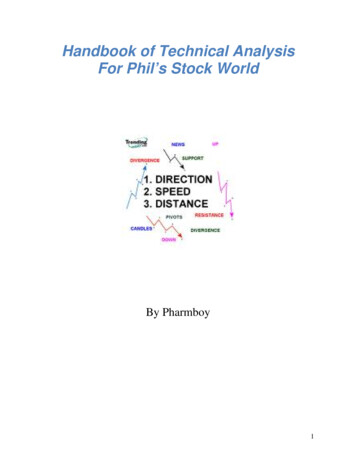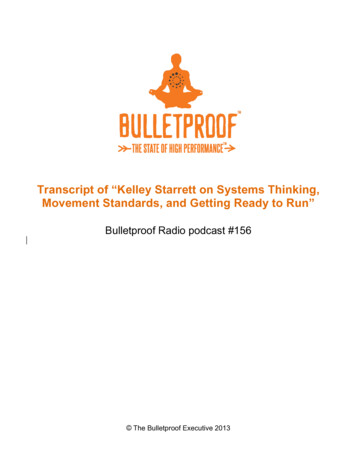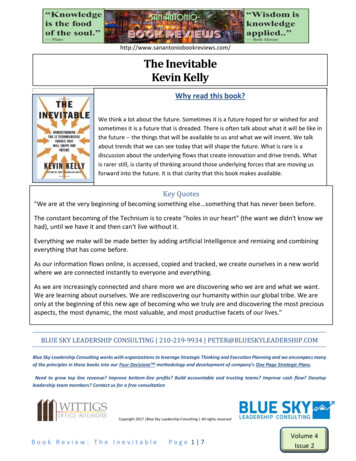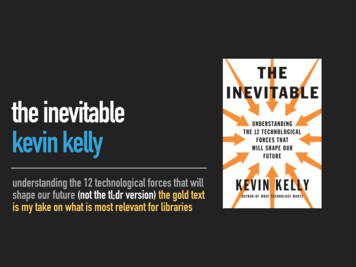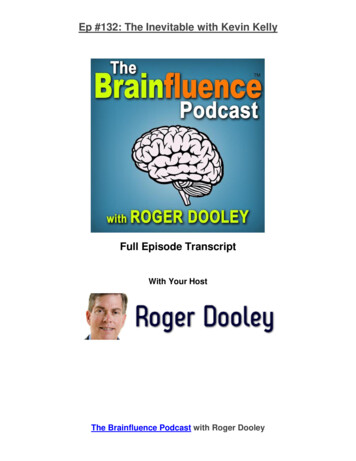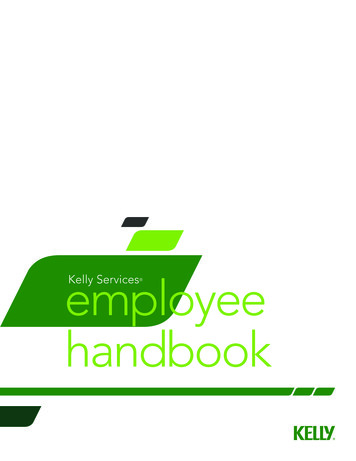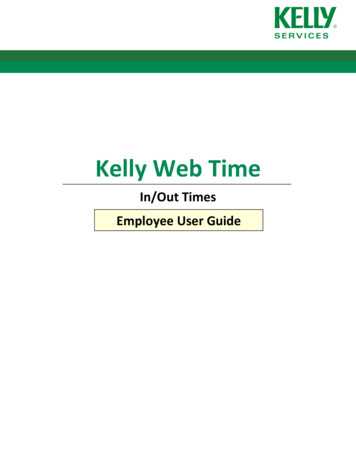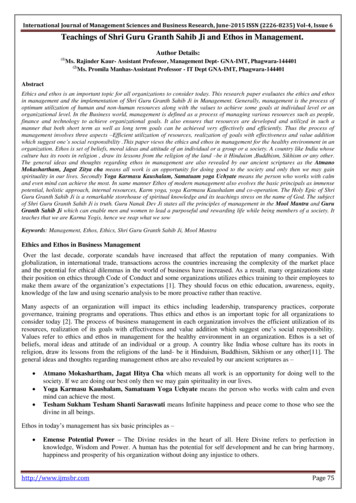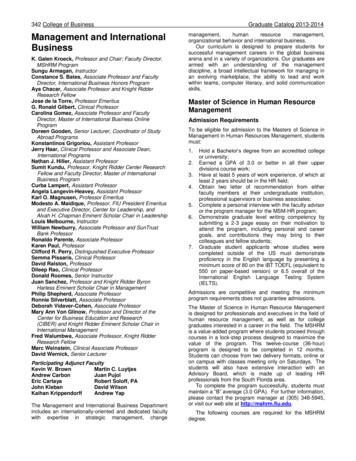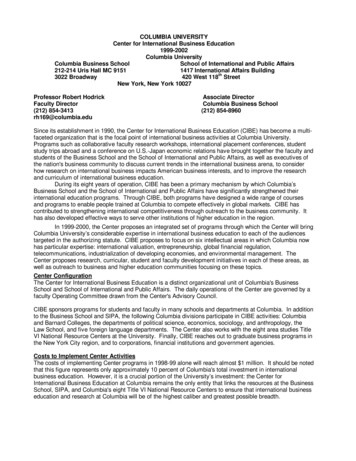
Transcription
Phil KellyINTERNATIONALBUSINESS ANDMANAGEMENTStudy GuideCLU-KELLY-08-0801-0FM.indd i1/21/09 4:58:53 PM
International Business & Management: Study GuideWelcome to the International Business and Managementcourse. This study guide (handbook) has been written forstudents enrolled on the course and contains a great deal ofinformation needed to complete your studies. You shouldbring it to each workshop session. Within the handbook youwill find:- A holistic concept model and module delivery plan- Detailed learning outcomes- Lecture summaries, specific lecture outcomes, a lecturesynopsis, and keywords, supporting text, figures, referencesand activities for each workshop- Towards the end of the handbook you will findsupplementary readings.The overall aim of this course is to develop the reader’sknowledge of the international organisation so that theyunderstand how resources and competencies (dynamiccapabilities) may be developed and used to survive andprosper in an uncertain and constantly changing world turning strategy into action through the effective andefficient management of resources and creation ofsustainable competitive advantage. We also aim to explainhow managers may create value for customers,shareholders, society and themselves.Throughout this course we take an eclectic andmultidisciplinary approach, drawing on both classic and newtheory from strategy, operations management, marketing,information systems, finance, human resource managementand the specific literature on international business andmanagement. Additionally, we recognise the strategic roleof HR in developing people as a source of competencedifficult for competitors to imitate; we discuss knowledgemanagement, the learning organization, HR practices andbusiness processes. We also recognise the important role ofinformation resources and technology and explain howenterprise systems, business intelligence, knowledgemanagement systems and e-business and e-commercesystems enable people and the corporate and businessstrategies. Human and information technology resources are5/188
International Business & Management: Study Guidealso considered in the specific primary activities ofoperations management, logistics, marketing and sales. Therole of finance and the management of financial resources inthe international organization are also considered along withtheir supporting systems. Throughout the course we consideremployee behaviour from a productive and ethical standpoint and emphasise the key role of leadership. Recognisingglobalization and change we also provide tools andframeworks to analyse international organizationalsurroundings both internally and externally and explain howchange can be managed in order to align the organizationwith its customers and environment.We believe today’s business student must see theorganization as more than simply a collection of functionalparts. Important capabilities are created from the way inwhich people (to include skills and know-how), information,financial and physical resources are tied together. Businessand management as a subject area is distinctive in that it isinterdisciplinary, drawing upon a wide range of basedisciplines from "hard to soft" sciences. This study guide, likethe associated text book, is organised in five parts: (1) anintroduction to international business and management, (2)international strategy, (3) human resource management, (4)managing information and technical resources and (5)international business and trade. Chapter one, anintroduction to international business and management,identifies what constitutes an international organisation,why they exist and how they are derived. Different types ofinternational organisation are considered alongside theactivities they undertake. This forms a basis for explaininghow resources are used effectively and efficiently, so thatorganisations can compete and attain their goals, thusperforming in a desirable manner. Part Two has a strategicfocus, introducing the factors which shape what theorganisation will do and where it will do it (purpose andscope). Part Two is more about the need to be effectivethrough an analysis of the environment and stakeholderneeds and the wisdom of its leaders, managers andemployees. We discuss how international organisationscompete and achieve their goals through efficient use ofresources and the selection of markets in which to offertheir products and services. Parts three and four focus onefficiency and act as the building bricks used by strategistsseeking to create sustainable competitive advantages. In6/188
International Business & Management: Study Guidepart two we focus more on challenges associated withorganisational behaviour and the use of human resources.Chapter six focuses on human capital as a source ofsustainable competitive advantage and considers theproblems associated with managing people worldwide.Chapter seven considers diversity and managingmulticultural groups of all sizes, understanding how to workwith people who may seem different. In chapter eight weconsider the need to organise human resources, to divide,allocate, coordinate and control activities so that theorganisational goals can be achieved. Chapter nine (businessprocesses) continues to focus on work design, turningattention to the structuring of work tasks enabling efficiencygains and an ability to be responsive whilst attaining timebased advantages. In part three we build on humanresources and consider how information and knowledgeresources can be managed. Manual or knowledge-basedwork activities can be enabled by ICT and the organisationcoordinated and controlled through the free flow ofinformation resources. Furthermore, synergies and scalebenefits may accrue for the international organisation whichtakes learning from one part and utilises it in another.Technologies discussed in chapters twelve and thirteen unifyorganisation and enable it to operate across boundaries.The final part focuses on business, creating, marketing andselling organisational outputs. Operations management,marketing and sales are the internal customers and users ofthe resources discussed in part three and four. They enablethe organisation to pool resources to execute the activitiesthat result in customer satisfaction and revenue generation.Finally, in chapter sixteen we consider the management offinancial resources worldwide.The emphasis of this course and associated text is more onthe need to develop agile companies that can meet changingcustomer needs in a timely and profitable manner.International management should take a supply chain andvalue system perspective, identifying how organizations canoperate more effectively and efficiently at a global level,.We focus on how organizations use their resources such asinformation, people, knowledge, technology and finances toachieve their goals and compete in the global marketplace.Recent years have brought sweeping changes in the wayorganisations apply information technology to solve complexproblems that are common in increasingly competitive and7/188
International Business & Management: Study Guideglobal business environments. All organizations today createsustainable value from leveraging their intangible assets –human capital; databases and information systems;responsive, high-quality processes; customer relationshipsand brands; innovation capabilities; and culture. Effectiveresource management can deliver competitive advantage;organizations must manage people, information, knowledgeand technological resources along with tangible goods andmaterials if they are to be responsive, innovative, effectiveand efficient.This course recognises that an organization has finiteresources and must decide on how best to use them todevelop strengths when pursuing opportunity worldwide. Akey assumption is that effective resource management candeliver competitive advantage; organizations must managepeople, information, knowledge and technology resourcesalong with tangible goods and materials if they are to beresponsive, innovative, effective and efficient. Studying thecontent and attending the course workshops should help youanswer questions such as:- What is the difference between business and internationalbusiness?- What are the components of an international businessstrategy?- How can firms develop a sustainable advantage in dynamicrapidly changing market conditions?- Specifically, how can the firm use information andknowledge resources, people and technology to createcompetitive advantage and how can such resources becombined to create capabilities?- Finally, what are the activities that must be undertaken toachieve the organizations' international goals and how canthe capabilities be deployed to enable the organizationperform such activities in a timely, efficient and effectivemanner?Throughout this course you need to be able to manage yourown learning: planning and time management skills areessential for this. You will need to learn with others: teamworking and communication skills will be important. Youwill need to locate and use a wide range of informationsources: this will require knowledge management skills. Butabove all you need to understand what learning means at8/188
International Business & Management: Study Guidethis level, why it is so important and how to do it well. Thiscourse presents opportunities for you to develop the skillsthat employers seek. In particular you will develop basicskills of reading, note taking, using numbers, findinginformation, working in groups, problem-solving, writingessays and reports, project and time management. You willdevelop the skills through class activities and assessments inparticular. We will draw on a variety of resources to supportyour skill development. What is of fundamental importanceis that you take ownership of developing yourself!Finally, we hope that you enjoy the course. We believe thatyou will get the most from this learning experience throughactive class participation, completion of the assessmenttasks and in-class activities and through the recommendedwider readings.9/188
International Business & Management: Study GuideContents PageForeword Contents Page Lectures1 AN INTRODUCTION TO INTERNATIONAL BUSINESS & MANAGEMENT2.1 ANALYSING THE GLOBAL BUSINESS ENVIRONMENT2.2 INTERNATIONAL AND GLOBAL STRATEGY2.3 BEHAVING RESPONSIBLY AROUND THE WORLD2.4 MANAGING CHANGE IN THE INTERNATIONAL ORGANIZATION2.5 INTERNATIONAL LEADERSHIP & MANAGEMENT3.1 MANAGING HUMAN RESOURCES3.2 MANAGING DIFFERENCE3.2 INTERNATIONAL ORGANIZATION DESIGN & CONTROL3.4 GLOBAL BUSINESS PROCESSES4.1 MANAGING INFORMATION RESOURCES4.2 MANAGING KNOWLEDGE4.3 GLOBAL BUSINESS & ENTERPRISE SYSTEMS4.4 GLOBAL DIGITAL BUSINESS5.1 INTERNATIONAL OPERATIONS MANAGEMENT5.2 INTERNATIONAL MARKETING5.3 MANAGING GLOBAL FINANCIAL RESOURCES6.1 GROUP WORK6.2 REFLECTIVE PRACTICE6.3 ESSAY AND REPORT WRITING6.4 PRESENTATIONS (ORAL)Glossary References Appendix Supplementary readings10/188
International Business & Management: Study GuideModule UnitsIn order to better structure the module we have grouped content into units. A list of the units is givenbelow.1 An Introduction to International Business & Management2 PLANNING FOR INTERNATIONAL BUSINESS3 MANAGING Human Resources4 MANAGING Information & Technological Resources5 INTERNATIONAL BUSINESS6 Study SkillsEach unit contains one or more lectures/ tutorials and is described in more detail overleaf.11/188
International Business & Management: Study Guide1An Introduction to International Business &ManagementAN INTRODUCTION TO INTERNATIONALBUSINESS & MANAGEMENTPart 1 contains a single chapter - An Introduction to InternationalBusiness & Management which aims to describe the nature andcomposition of international organizations are and examine why theyexist. We start with a case study of one of Europe’s largest internationalorganizations (Nestlé). The case study highlights several importantconcepts such as the environment and globalization, strategy, corporatesocial responsibility, change and leadership – all of which are consideredin detail throughout the second part of the book. In chapter 1 we introducethe fundamental challenges faced by the international organization anddiscuss the major assumptions that guide resultant decisions andbehaviour.International Organizations are considered as a bundle of resources,scattered around the globe and brought together by shared goals,common assumptions and the need to perform in a manner that assuressuch goals are met. In meeting goals international organizations must beboth effective and efficient in the way resources are utilised. Perhaps themost important assumption governing business activities and theorganisation and utilisation of resources concerns the way theorganization interprets the worldwide marketplace. The internationalorganization may adopt a convergence and integrated view – the world isa single market – or divergent view – the world is a collection of many(country) markets. Through the opening case study we examine Nestlé’smarket assumptions and then market assumptions of other organizationsthroughout the book. We will note implications for strategy, organizationalstructure, processes and activities and systems. For example, oneproblem faced by all international organizations concerns the use ofinformation resources and technology. Should this be standardised andintegrated on a world-wide scale or should each subsidiary or countryoperation manage their information resources and technology? Similarproblems may be framed with regard to organizational culture, structureand other systems within the international organization. Assumptionsabout performance also impact upon organizational activities and the way12/188
International Business & Management: Study Guideresources are used. Whereas some organizations see their role solely interms of maximising shareholder wealth, others may take a widerperspective and will consider a broader set of stakeholders when makingbusiness decisions; they may strive to create shared value for society.We can understand a great deal about organizations from anunderstanding of their basic assumptions.Later in chapter 1 we distinguish between international business andinternational management and the associated strategic perspectives ofmarket positioning and the resource based view. Assumptions about howbest to compete and win business - to choose where best to compete orwhat best to compete with – impact upon strategy, resource allocationand utilisation decisions. Finally, we conclude this part of the book witharguments about what should be studied in the field of internationalbusiness and management and discuss why this particular coverage isappropriate. Overall, part 1 sets the scene for subsequent parts of thebook.13/188
International Business & Management: Study Guide2PLANNING FOR INTERNATIONALBUSINESSANALYSING THE GLOBAL BUSINESSENVIRONMENTINTERNATIONAL AND GLOBAL STRATEGYBEHAVING RESPONSIBLY AROUND THEWORLDMANAGING CHANGE IN THEINTERNATIONAL ORGANIZATIONINTERNATIONAL LEADERSHIP &MANAGEMENTInternational organisations are resource systems continuously interactingwith their environment - a source of opportunity, threat and constraint.The environment provides the organisation with a purpose, and shapesits mission and goals. It governs what the organisation will do (activities)and how it will do it. An understanding of both external and internalenvironments (chapter 1), the requirements of significant stakeholdersand the preferences and senior decision-makers shape the organisationalstrategy - where and how to compete, and the identification andapplication of required resources. In chapter two we consider howstrategy is developed and implemented. The chapter (international andglobal strategy) seeks to answer fundamental questions such as: in whichmarkets and geographical areas will we compete, how will we competeand what resources and capabilities do we require. Strategy isconcerned with how the international organisation achieves its aims andgoals. Stakeholders, other than investors, must be considered whenformulating strategy and conducting business activities. In chapter threewe consider how organisations can behave responsibly when operatingworldwide. Once strategy has been formed or strategic decisions made,changes must take place. Change is necessary in a dynamicenvironment and various theories of change are explored in chapter four.We explore what can be changed and how the international Organisationcan accomplish change. Finally, in chapter five we recognise the role ofleaders and managers in strategy, ethical and change management and14/188
International Business & Management: Study Guidebehaving responsibly. They play a key role in planning, designing,allocating resources, coordination, control, setting direction andmotivating.The challenge of strategic management is to understand complex issuesfacing organisations and develop the capability for long-termorganisational success. The aim of this section is to develop the reader’sknowledge of the need and means to align the organization with itsenvironment so its resources can be developed and deployed to meet itsgoals.The overall aim of the book (Kelly 2009) is to ensure the internationalorganisation has the resources and competencies (dynamic capabilities)to survive and prosper in an uncertain and constantly changing world. Tosurvive and prosper an organisation needs to address the challenges itfaces from the environment. In particular it must be capable of deliveringagainst the critical success factors that arise from demands and needs ofits customers. The strategic capability to do so is dependent oninternational organisational resources, competencies and capabilities.15/188
International Business & Management: Study Guide3MANAGING Human ResourcesMANAGING HUMAN RESOURCESINTERNATIONAL ORGANIZATION DESIGN &CONTROLMANAGING DIFFERENCEGLOBAL BUSINESS PROCESSESThis part identifies ways in which the performance of the internationalorganization may be improved through usage of human resources andthe effective management of people. After completing studies in thissection of the book you should be able to: Explain how the managementof human resources may lead to sustainable completive advantage;analyse and synthesise designs and structures for the internationalcompany; discuss the need for cultural competence and benefits ofdiversity management in international companies; critically evaluatealternative mechanisms for control and coordination in internationalcompanies and explain how global business processes may be modelledand the approaches used plus reasons for striving to continuouslyimprove them. This part of the book has four related chapters:MANAGING HUMAN RESOURCESMANAGING DIFFERENCE - CULTUREINTERNATIONAL ORGANIZATION DESIGN & STRUCTUREGLOBAL BUSINESS PROCESSESIn part three we focus on the attainment of organisational goals, thestrategy and sustainable competitive advantage through peopleresources. When people are motivated, satisfied, committed, loyal, able,skilled, knowledgeable and competent they become capable ofperforming organisational goals efficiently, whilst delivering value, qualityand innovation. As components of the transformational processdiscussed in chapter four, when aligned with other resources such as16/188
International Business & Management: Study Guidemanagement and information systems and technology they form a bundleof resources which are difficult to imitate and therefore a source ofsustainable competitive advantage. The first chapter focuses on theworldwide management of human resources-how to make the mostefficient use of human resources in the international context. The role ofthe HR specialist is considered alongside the components of the HRsystem: philosophy, HR policies and practices. We investigate challengesassociated with the application of such a system worldwide, particularly interms of their universal application. The tension associated with a needfor integration and differentiation is considered in terms of the diffusion ofHR practices throughout worldwide operations. In the next chapter wefocus on managing difference and assuring people are able to workproductively with one another regardless of these differences. Inparticular, we focus on working with other cultures, across borders. Weargue the business case for diversity, explaining how the multiculturalorganisation can be a source of sustainable competitive advantage.Multicultural group work is explained along with the associated positiveand negative work outcomes. This is an essential precursor for the finalchapter, process organisations, which are dependent on teamwork. Inthe third chapter we identify the organisational mechanisms used tocontrol and coordinate worldwide operations. We explain the need todivide and allocate work and the different philosophies, systems anddesigns used for such division and allocation. Ultimately the aim will beto design an international organisation which is globally competitive,flexible, adaptable and able to share and develop resources andcapabilities. In the final chapter we focus more on how work gets donewithin the international organisation. Building on the value chain conceptdiscussed in chapter two, we decompose the primary and secondaryvalue adding activities into business processes, sub processes andtasks. The link is made between work, people, structure, processes,culture, information systems and technology and an alignment modelpresented. In this chapter, the problems of traditional work design andstructure are explored and the benefits of a horizontal orientationdiscussed. We highlight how resources may be used through a horizontalfocus to best add value and deliver customer requirements in an optimumway. This final chapter paves the way for the following part of the bookwhich discusses information resources and technology.17/188
International Business & Management: Study Guide4MANAGING Information & TechnologicalResourcesMANAGING INFORMATION RESOURCESMANAGING KNOWLEDGEGLOBAL BUSINESS & ENTERPRISESYSTEMSGLOBAL DIGITAL BUSINESSAt the beginning of the book we noted that organisations seek to meettheir goals through superior performance. We suggested there weremany ways by which the international organisation can achieve this, suchas through the possession of sustainable competitive advantages. Weargued that operational effectiveness (performing similar activities betterthan rivals perform them-being effective and efficient) and strategy areessential for superior performance. A company can outperform rivals inthe long run, only if it can establish a difference that it can preserve.Such differences often require constant work to develop and maintain.The international organisation must deliver greater value or greatercomparable value at a lower cost or both. Differences betweencompanies in cost, price, product or service derive from the hundreds ofactivities undertaken by the organisation and its partners. Cost isincurred performing activities through the use of resources (input ortransformational). Organisations are therefore consistently in pursuit ofoperational improvements in productivity, quality and the time taken tocomplete tasks. They must get more out of resources, employ moreadvanced technology, motivate and enable human resources better.They must also seek out differences in the way they do things to createunique and valuable positions. In the introductory chapter weemphasised the need to leverage resources and capabilities.In the previous part (chapters six to nine) we focused on peopleresources, the role of human resource specialists, the need for structure,coordination and control, the need to design work and motivate people tocomplete work tasks and to manage diversity. We noted that peoplecould be enabled by technology-machines replacing manual tasks andInformation Systems helping with thinking activities. Communications18/188
International Business & Management: Study Guidetechnologies support coordination and control and, with information flow,tie or unite organisational parts so that the organisational system canattain its goals through synergy and holism. We have adopted a resourcebased approach to this and the previous part of the book. Thefundamental principle of the RBV is that the basis for competitiveadvantage lies primarily in the application of bundles of valuableresources which, when integrated create, capabilities and organisationalcompetence.Whilst we focused on human resources in the previous part, people arearguably components of information systems also. In this part of the bookwe focus on information system resources which include hardware,software, communication technologies and data. Systems theory is usedto unite such resources. In this part we consider knowledge as aninformation resource. In some cases that knowledge is embedded inpeople (human capital) and in other cases is embedded in culture ororganisational systems. We also consider the hardware, software andprocesses and communication technologies that enable its capture,transfer and use in transformational activities. Various IT resourcesconsidered in this part of the book enable the free flow of information(enterprise systems) throughout the organisation in support of commerce,planning, decision-making, control and coordination. Finally we considerthe role of Internet technologies as the “glue” and “conduit” for bundlingresources together, making them available for work and value addingactivities. We will argue that information system resources arestrategically important resources, enabling and informing strategy,creating capabilities and competences when bundled with otherresources. Collectively, this and the previous part of the book can beused to explain the organisational system proposed by Leavitt (1965), seeFigure 5- 2 and when coupled with the strategy part provide a detailedunderstanding of Nadler and Tushmans’ organisational model shown inFigure 5- 3 . They define what the organisation is and how it competes inthe global marketplace and provide a strong foundation for the final partof the book which makes use of this organisational system in the primaryinternational business and trade activities of production, marketing andsales.As can be seen from the figure, this part is structured into fourchapters: information resources (foundation concepts), Knowledgeresources, enterprise systems and digital (net) technologies.19/188
International Business & Management: Study Guide5INTERNATIONAL BUSINESSINTERNATIONAL OPERATIONSMANAGEMENTINTERNATIONAL MARKETINGMANAGING GLOBAL FINANCIALRESOURCESThe core book has five parts, this is the final one. At the outset of thebook we described the context for international business andmanagement and used this, in part two, to focus on the scope of theorganization (strategy) – the purpose, goals and mission; the businessthe company is in and the development of a plan of action. Through this,and leadership, managers come to understand how they ought todevelop, allocate and utilise resources to business advantage. Parts 3and 4 focussed on resource management. Resourcing encompasses theacquisition, development and deployment of human, technological andother resources to create capabilities; an ability to achieve the mission. Inthis final part we focus on the actual work that is done; bringing togetherthe resources and capabilities to provide the goods and services forconsumers and thus generate a financial return. In this part we seek tomake optimum use (productivity) of the resources discussed in parts 3and 4 and to administer the whole business effectively and efficiently andin accordance with the strategy. Our focus is on the primary tasks andprocesses that cut across management, to add value and realise goals.As a consequence, financial resources are also acquired, utilised andgenerated; they to must be managed.This part includes:INTERNATIONAL OPERATIONS MANAGEMENTINTERNATIONAL MARKETINGINTERNATIONAL FINANCEIn this part we explore the primary activities of operations (usingcapabilities to add value and create offerings) and marketing (exchanging20/188
International Business & Management: Study Guideofferings for revenue) and finish with the supporting financial processesand associated challenges for the international organization.6Study SkillsGROUP WORKREFLECTIVE PRACTICEESSAY AND REPORT WRITINGPRESENTATIONS (ORAL)This unit contains session notes to support student business skilldevelopment, providing essential guidance to the core areas of practical,aspirational and transferable skills needed by a student both to achievesuccess on any academic course and to secure improved grades. It willalso develop key workplace skills that will enable them to achievesuccess in their onward career. It covers the key issues for today’sstudents, such as critical thinking & analysis, reflective practice & logicand plagiarism to ensure they’re fully equipped prepared for success.21/188
International Business & Management: Study Guide1AN INTRODUCTIONTO INTERNATIONALBUSINESS &MANAGEMENT22/188
International Business & Management: Study Guide1AN INTRODUCTION TO INTERNATIONALBUSINESS & MANAGEMENTDistinguish between types of internationalorganizationsSynopsis:Explain what is meant by globalization and itsimpact upon organizations worldwideINTRODUCTION TO INTERNATIONAL BUSINESS,THE INTERNATIONAL ORGANIZATION andINTERNATIONAL ORGANIZATIONAL PERFORMANCEDescribe the resource based view (RBV) andexplain its relationship with productive activitiesand sustainable competitive advantageDescribe the trade theories typically associatedwith the economic activities of internationalbusinessKey concepts introduced in this chapterInternational Organization Multinational Companies Value Chain Value System InternationExplain the diff
Business and management as a subject area is distinctive in that it is interdisciplinary, drawing upon a wide range of base disciplines from "hard to soft" sciences. This study guide, like the associated text book, is organised in five parts: (1) an introduction to
